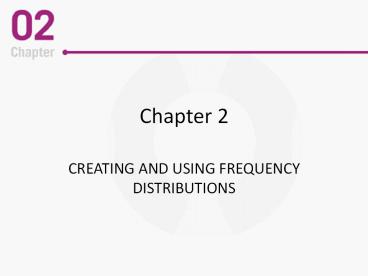Creating and Using Frequency Distributions - PowerPoint PPT Presentation
1 / 31
Title:
Creating and Using Frequency Distributions
Description:
Title: Basic Statistics for the Behavioral Sciences Author: Deborah J. Hendricks Last modified by: Windows User Created Date: 4/29/2002 1:59:42 AM – PowerPoint PPT presentation
Number of Views:97
Avg rating:3.0/5.0
Title: Creating and Using Frequency Distributions
1
Chapter 2
- Creating and Using Frequency Distributions
2
Going Forward
- Your goals in this chapter are to learn
- What frequency is and how a frequency
distribution is created - When to graph frequency distributions using a bar
graph, histogram, or polygon - What normal, skewed, and bimodal distributions
are - What relative frequency and percentile are and
how we use the area under the normal curve to
compute them
3
New Symbols and Terminology
- Raw scores are the scores we initially measure in
a study - The number of times a score occurs in a set of
data is the scores frequency - A frequency distribution organizes the scores
based on each scores frequency
4
New Symbols and Terminology
- The frequency of a score is symbolized by f
- N is the total number of scores in the data
5
Understanding Frequency Distributions
6
Frequency Distribution
- A frequency distribution table shows the number
of times each score occurs in a set of data - N is the total of all the individual frequencies
in the f column of a frequency distribution table
7
Raw Scores
- Use the following raw scores to construct a
frequency distribution table.
14 14 13 15 11 15
13 10 12 13 14 13
14 15 17 14 14 15
8
Frequency Distribution Table
9
Graphing Frequency Distributions
- A frequency distribution graph always shows the
scores on the X axis and their frequency on the Y
axis - The type of measurement scale (nominal, ordinal,
interval, or ratio) determines whether we use - A bar graph
- A histogram
- A polygon
10
Frequency Bar Graph for Nominal and Ordinal Data
11
Histogram for a Small Number of Different
Interval or Ratio Scores
12
Frequency Polygon for Many Different Interval or
Ratio Scores
13
Types of Frequency Distributions
14
The Normal Distribution
- A bell-shaped curve
- Called a normal curve or a normal distribution
- Symmetrical
- The far left and right portions containing the
relatively low-frequency, extreme high or low
scores are called the tails of the distribution
15
An Ideal Normal Distribution
16
Skewed Distributions
- A skewed distribution is not symmetrical as it
has only one pronounced tail - A distribution may be either negatively skewed or
positively skewed - The direction in which the distinctive tail
slopes indicates whether the skew is positive or
negative
17
Negatively Skewed Distribution
- A negatively
- skewed distribution contains extreme
- low scores having low frequency, but
- does not contain low-frequency, extreme high
scores.
18
Positively Skewed Distribution
- A positively
- skewed distribution
- contains extreme
- high scores having low frequency, but
- does not contain low-frequency, extreme low
scores.
19
Bimodal Distribution
- A bimodal
- distribution is a
- symmetrical
- distribution
- containing two
- distinct humps.
20
Frequency Distribution Shape
- The shape of the frequency distribution is an
important characteristic of the data - The shape also determines which statistical
procedures we should use
21
Relative Frequency and the Normal Curve
22
Relative Frequency
- Relative frequency is the proportion of the time
a score occurs in a sample - The formula for computing a scores relative
frequency is - Relative frequency
23
Finding Relative Frequency Using the Normal Curve
The proportion of the total area under the normal
curve occupied by a group of scores corresponds
to the relative frequency of those scores.
24
Understanding Percentile and Cumulative Frequency
25
Percentile
- A percentile is the percent of all scores in the
data located below a score - One way to determine a scores percentile is to
find the area under the normal curve to the left
of the score
26
Cumulative Frequency
- The cumulative frequency is the number of scores
in the data that are at or below a particular
score.
27
Percentiles
Normal distribution showing the area under the
curve to the left of selected scores.
28
Example
- Using the following data set, find the relative
frequency and cumulative frequency of the score
12.
14 14 13 15 11 15
13 10 12 13 14 13
14 15 17 14 14 15
29
Example
- The frequency table for this set of data.
30
ExampleRelative Frequency
- The frequency for the score of 12 is 1 and N 18
- Therefore, the relative frequency of 12 is
Relative Frequency
31
ExampleCumulative Frequency
- There is one score at 12 and two scores below 12
(one score of 11 and one score of 10) - Therefore, the cumulative frequency of 12 is 3































